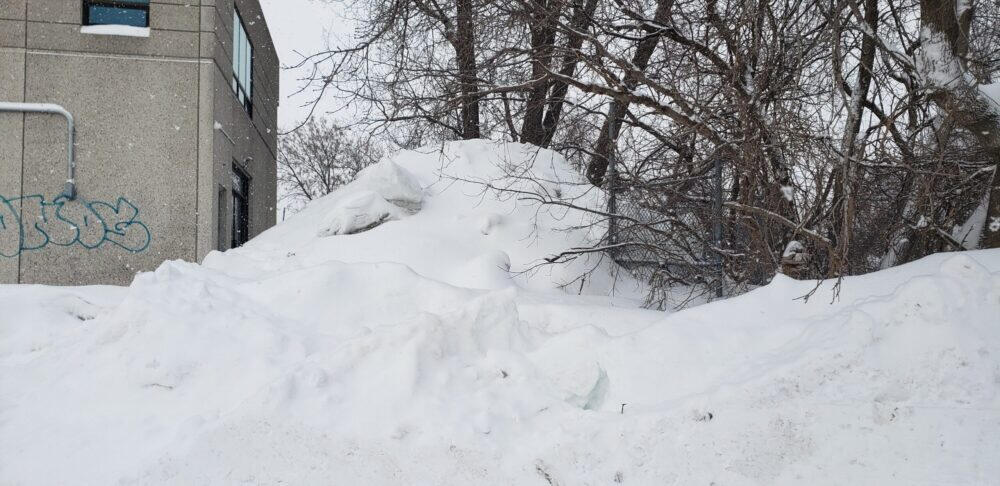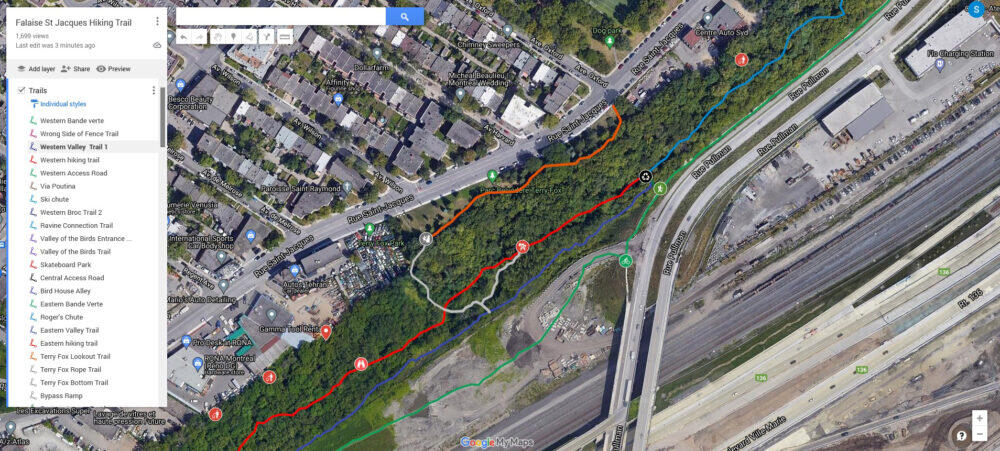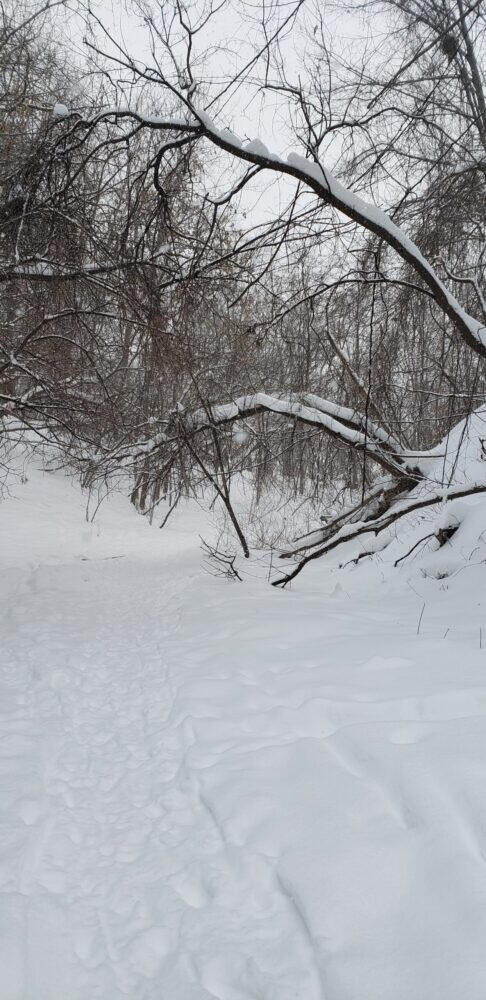BLOG
La Falaise St-Jacques: an Urban Nature Escape
From a seemingly unassuming area behind a commercial strip parking lot, is the hidden St-Jacques boulevard entrance to the ‘la falaise’ (French for ‘the cliff’) nature preserve/trail (located in the Montreal borough of NDG). This being my second visit to this welcomed slice of nature since last October, I decided this time to make this winter trek in my snowshoes. For reasons of space and time, I won’t go too much into the history of ‘la falaise’ here, but have included links to various local organizations that have compiled all the relevant and useful information below. That being said, the nature zone covers an elongated stretch of land roughly 7km (approx. 4.4 miles) stretching from east (on the western edge of St-Henri) to west (to the Ste-Anne-de-Bellevue autoroute interchange in NDG), with the general width of the nature trail being somewhat narrow in the 300 to 400 meter range (approx. 300 to 450 yards). The nature trail is essentially boxed in by a busy autoroute and interchanges to the south-east and south-west; and to the north side, a commercial strip running along St-Jacques boulevard (with a mixed residential and commercial situation north of St-Jacques blvd).
Upon entering through the valley of the birds path, I was surprised to see that the trail was well defined and the snow cover tapped down by the presence of previous trekkers and users (walking, cross-country skiing and snowshoeing). I quickly surmised that many people use the trail even during the winter season, since there was quite a significant amount of snow precipitation in recent days to completely cover the pre-defined trails. My goal was to follow the trail to the end of the east St-Henri Pullman st. entrance and back. One of the first things that becomes quickly apparent to the observant mind, is how bent, crushed and perturbed the vegetation is, with tree trunks and branches arced, twisted, snapped and mangled. This is the result of the acute sloping of the topography (45 degree slope in some areas) and the amount and weight of snow mass that accumulates at the very top of the upper cliff terrain line; the side-effects of repeated snow removal and dumping operations throughout the decades, coming from the commercial parking lots above and adjacent to the upper cliff topographical profile. In other words, tons of snow simply tumbles down the cliff and through sheer weight and momentum, damages even the tallest and most mature of trees in its wake. Slopes and cliffs in natural landscapes are generally tough environments for forest vegetation and animals alike. However, the effect gives the forest a wild and gothic appearance, which is a welcome sight given that the forest trail is surrounded by urban and commercial activity and infrastructure.
Along the trail, one notices gardening implements, site-specific art installations and bird feeders strategically placed. Because of the hard work and devotion of various groups and organizations (some appear to be self-organised collectives from different interest groups: bird watchers, forest gardeners and horticulturalists, artists and outdoor aficionados), the trail landscape is maintained, bird feeders replenished, trails cleaned of debris and other obstructions, and from what I observed, self-organizing groups plant new indigenous species, identify and maintain them. One immediately realizes that there are many people and groups who care for this unique micro-biome environment. Their level of passion, care, interest and labour are very appreciated.
The trail is a haven for birds of different species. Although not all the cliff forest’s vegetation species are indigenous, many indigenous bird species are found nesting in the forest cover and feeding on whatever food sources are available from existing shrubs and trees and the generous number of bird feeders spread along the trail (see links below for more information concerning the ‘la falaise’ bird species). Another obvious observation about the makeup of the cliff forest vegetation is, that it’s largely formed of deciduous species, mostly indigenous but also mixed with others that are naturalized. Birds, animals and the wind will carry and deposit whatever seeds are ingested and transported over great distances, and it’s a fact of life that has to be accepted. In the end, nature (with the help of conscious and knowledgeable people) will find the right balance. During my previous trek in October of last year, I was able to observe the presence of Hackberry (Celtis occidentalis), varieties of Maple (Acer), Ash (Fraxinus) and Poplar (Populus), including Oak (Quercus), just to name but a few. In this winter season, it’s also quite easy to identify the wild grape vines (Vitis riparia Michx.) hanging from tree branches all along the trail – an edible species by the way. One suggestion (e.g. for the guerrilla gardener) that would serve the cliff forest habitat very well, would be the introduction of coniferous species such as pine (Pinus – some varieties are pollution tolerant), especially toward the southern border of the cliff along its length where there is more sun exposure, Spruce (Picea), Cedar (Thuja occ.) and Canadian Yew (Taxus canadensis – although a slow grower, does very well in shaded areas).

Wheelbarrow covered in snow – waiting for Spring time
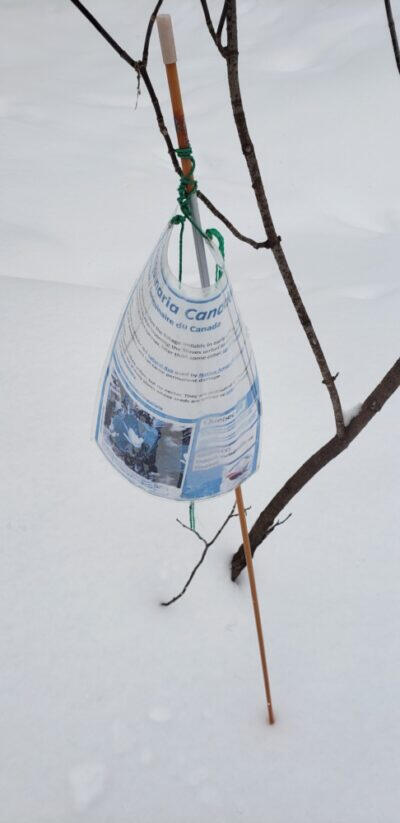
Species identification tags along the trail
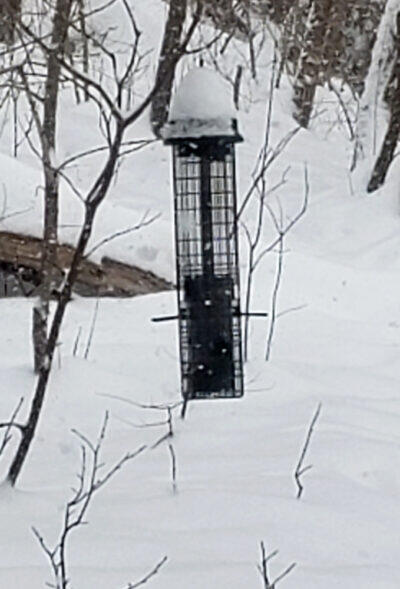
Bird feeders seen along the trail
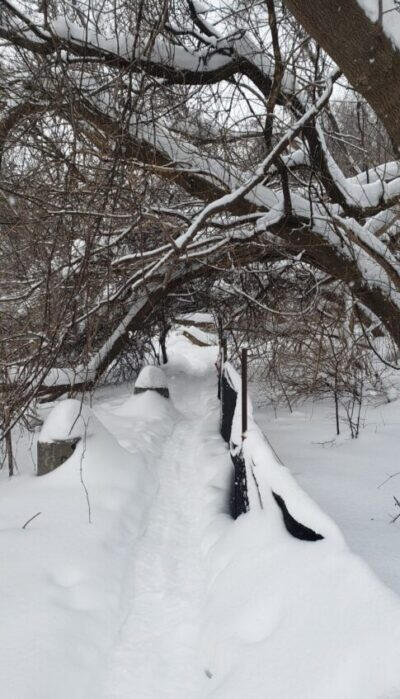
East entrance/exit of La Falaise trail in St-Henri
On the permaculture end of things, during my last Autumn trail walk, I didn’t really notice any attempts or visible signs of food forest edible growing activity. There could be a few logical reasons to explain this: 1) the slope conditions and degree of maintenance involved on the land could prove to be too challenging (although, I’m personally not leaning in that direction); 2) it is possible also that municipal regulations forbid any cultivation of edibles on the land, due to food harvest safety (e.g. the soil may be contaminated as the cliff forest zone was subjected to decades of man-made industrial pollution; that entire area to the south and east of the ‘la falaise’ forest, was the industrial heartland of Montreal during the industrial revolution period and all the way through to the late 1970s); 3) it is also possible that the thought of growing edibles hasn’t really occurred to gardeners and people frequenting the trail (again, I don’t really subscribe to that explanation. But, one never knows?).
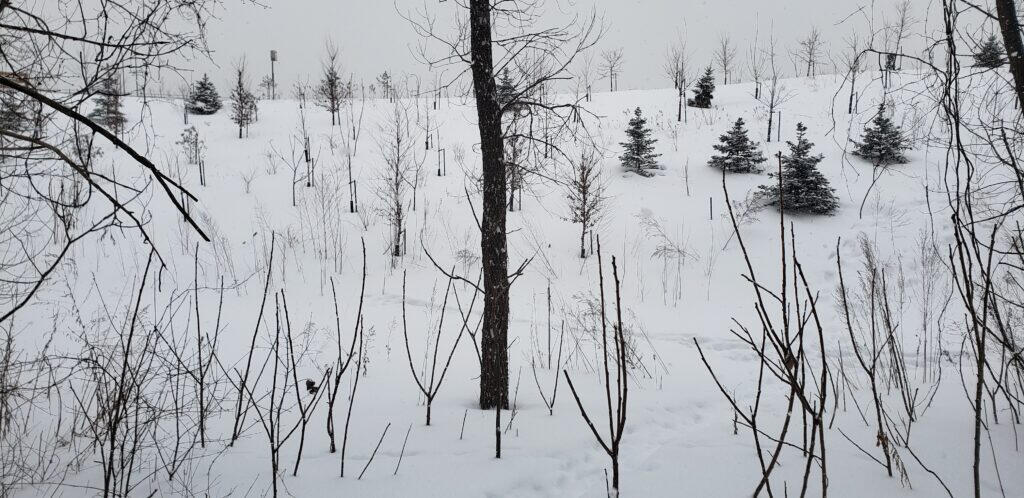
Turcot yard buffer zone – new plantings
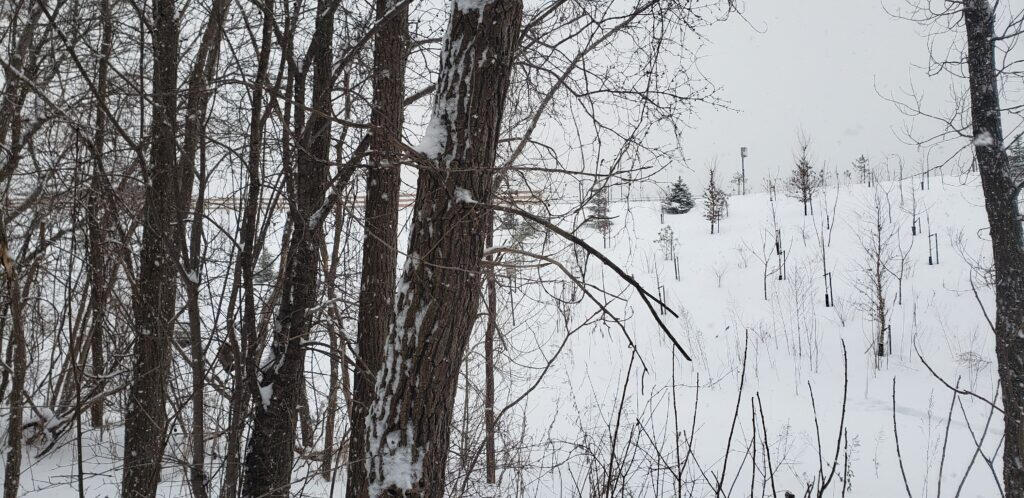
Turcot yard gully area – meadow-like wet zone
Of interest and importance too, is the landscaping intervention that was designed and executed during the Turcot yards (former train yards) urban/civil reconstruction project that was completed a few years ago, which also stretches along the autoroute to the south of the ‘la falaise’ forest. In between the former Turcot area (which also is parallel to the ‘la falaise’ forest east-west length) and the south edge/border of the ‘la falaise’ forest, there is also a gully/depression zone, which one can consider to be a type of wet marsh area, especially during the Spring, where a community of opportunistic plants grow in what looks like an improvised meadow (very interesting micro-eco-zone). This zone acts as a sound and visual buffer screening the viewer/experiencer from the autoroute activity above and to the south. Kudos go to the care and work done with regards to the planting strategy executed in the recent Turcot yard project (i.e. the new landscaped area) , and the choice and variety of indigenous plants, shrubs and trees planted along the way (very good mix of deciduous, coniferous, pollinator and habitat sympathetic species). A very nice compliment to the older and more mysterious ‘la falaise’ forest growth.
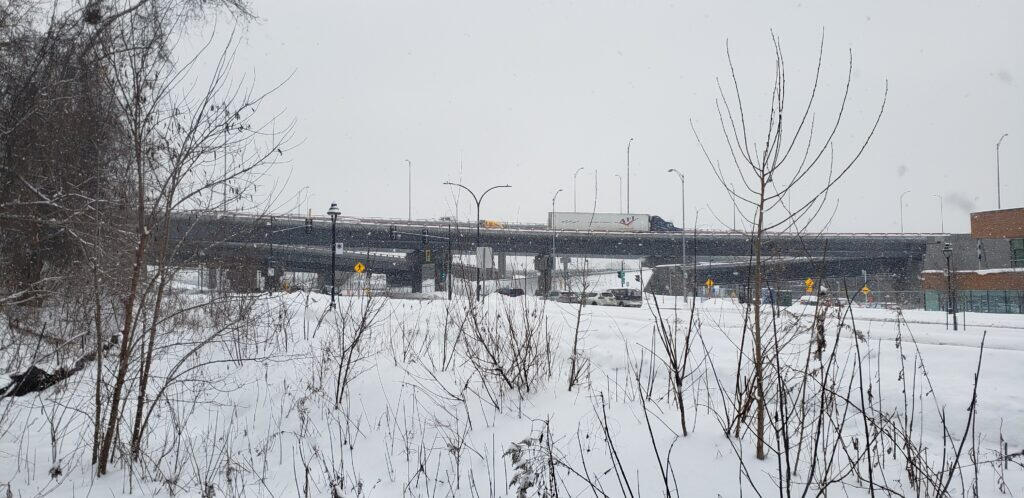
La Falaise East access entrance - Pullman street in St-Henri
Lastly, the main reason why people will escape to the ‘la falaise’ forest in order to walk, trek, garden and putter around or simply to contemplate life, is to have the opportunity to leave their urban nests and workplaces for an hour or two away from the stresses and worries of daily life. A chance to fill-up on a slice of nature in the city, greenery (biophilia), sunshine (vitamin D) and exercise (general health). While I was snowshoeing on my way back to my point of entry and through the valley of the birds, I encountered two people walking their dogs. We had a short friendly chat and all agreed on the importance and gift that is the ‘la falaise’ trail. A great area to meet like-minded souls and nature lovers. Besides those two folks and their dogs I encountered, I was basically alone on the trail; it was a unique opportunity to reconnect with nature and my inner self if not for just a short two hour break. If you happen to be in the neighbourhoods of NDG or St-Henri and not far away from any of the three entrances leading to the ‘la falaise’ forest, explore the trail and you might just discover a piece of nature you never thought existed, cleverly hidden and nestled in between busy autoroutes and inesthetic commercial buildings.
La Falaise Sources and Information:
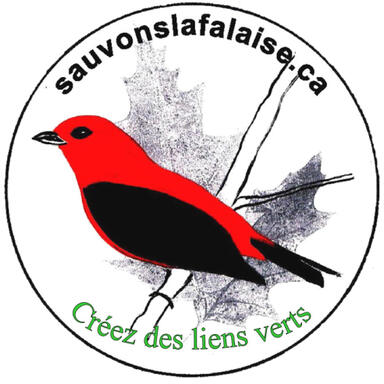
Videos
Virtual tour of La Falaise St-Jacques - C-rod Fishing Montreal
The Transformative Falaise St-Jacques - Pimento3
Pierre Duranleau
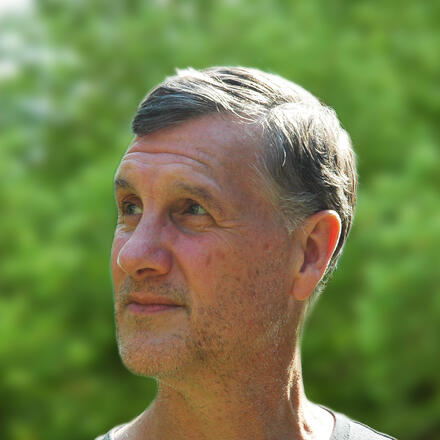
Permaculture, Landscapes & Gardens: Designer, Consultant, Implementer, Practitioner & Trainer
Pierre Duranleau - Copyright/Tous droits réservés - 2025
